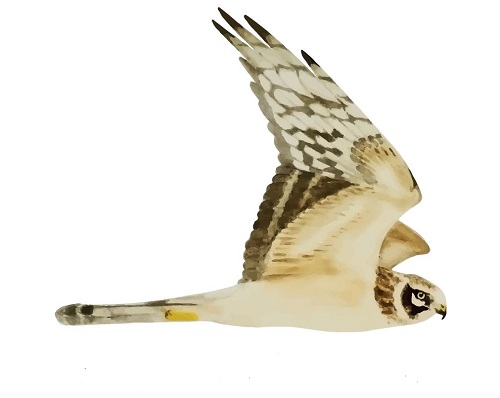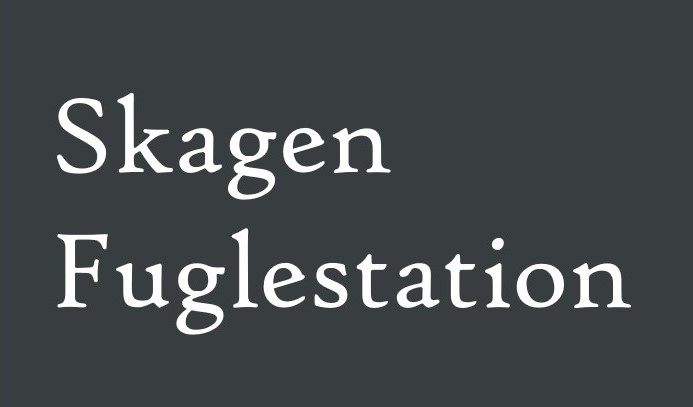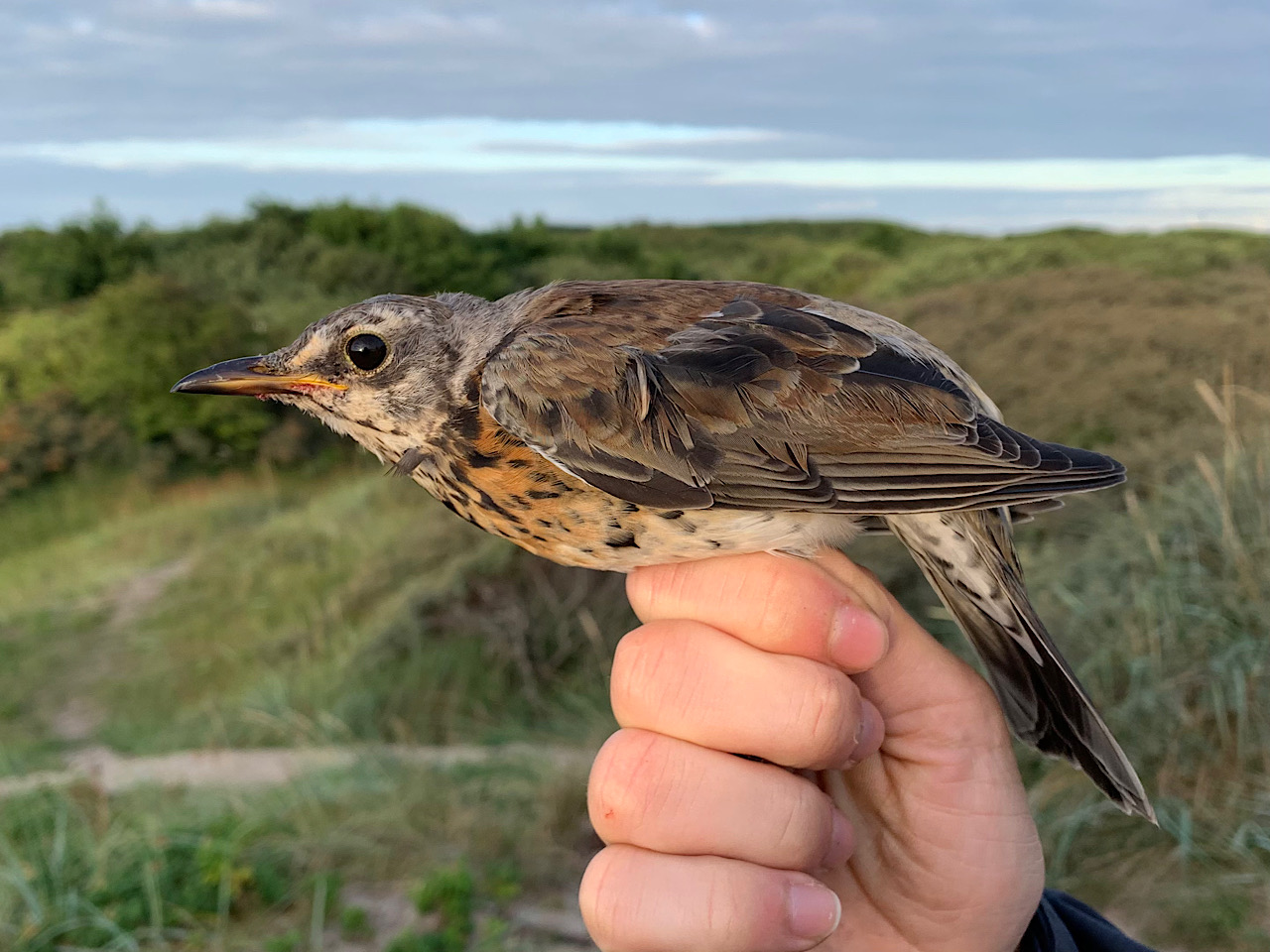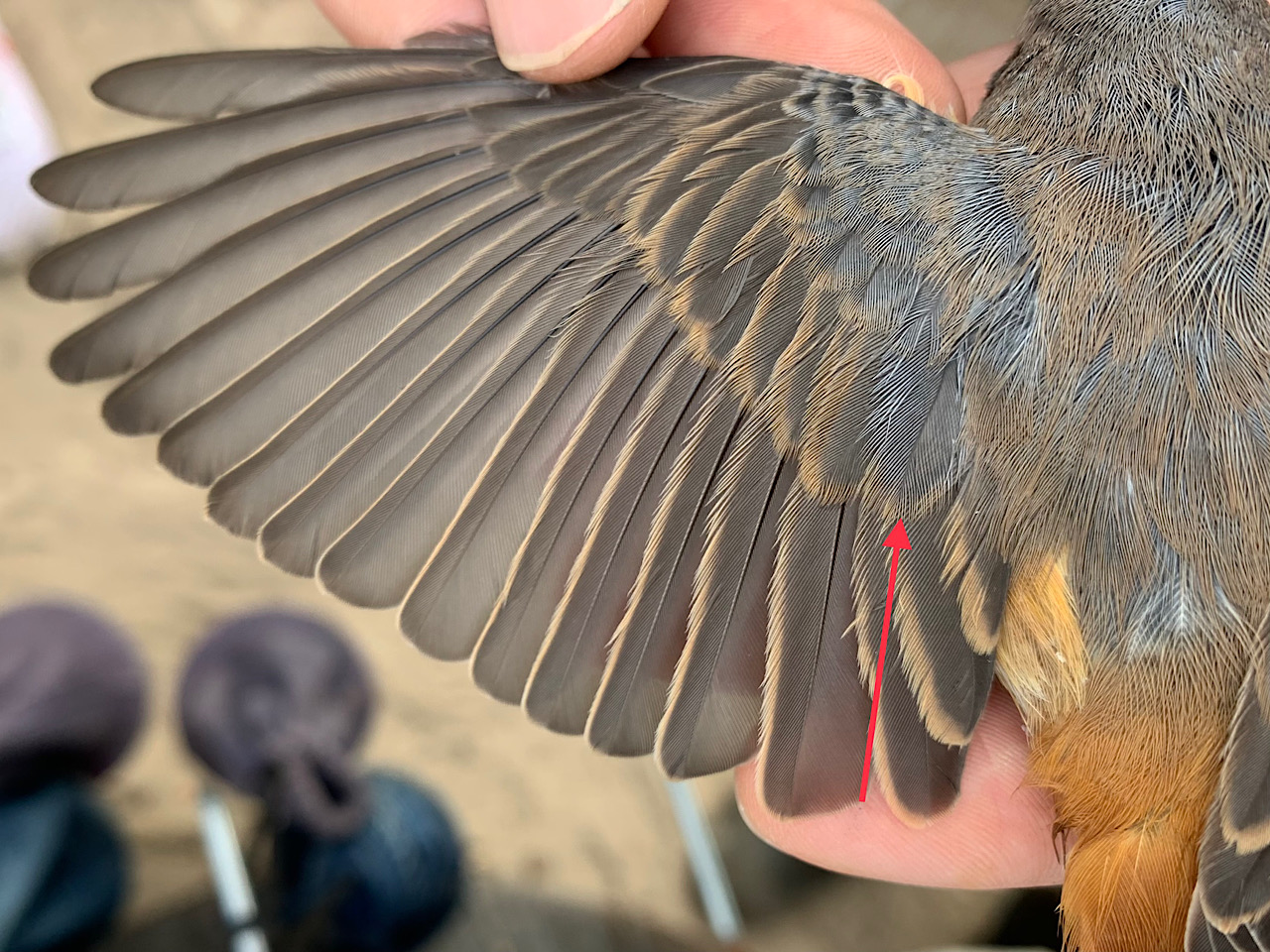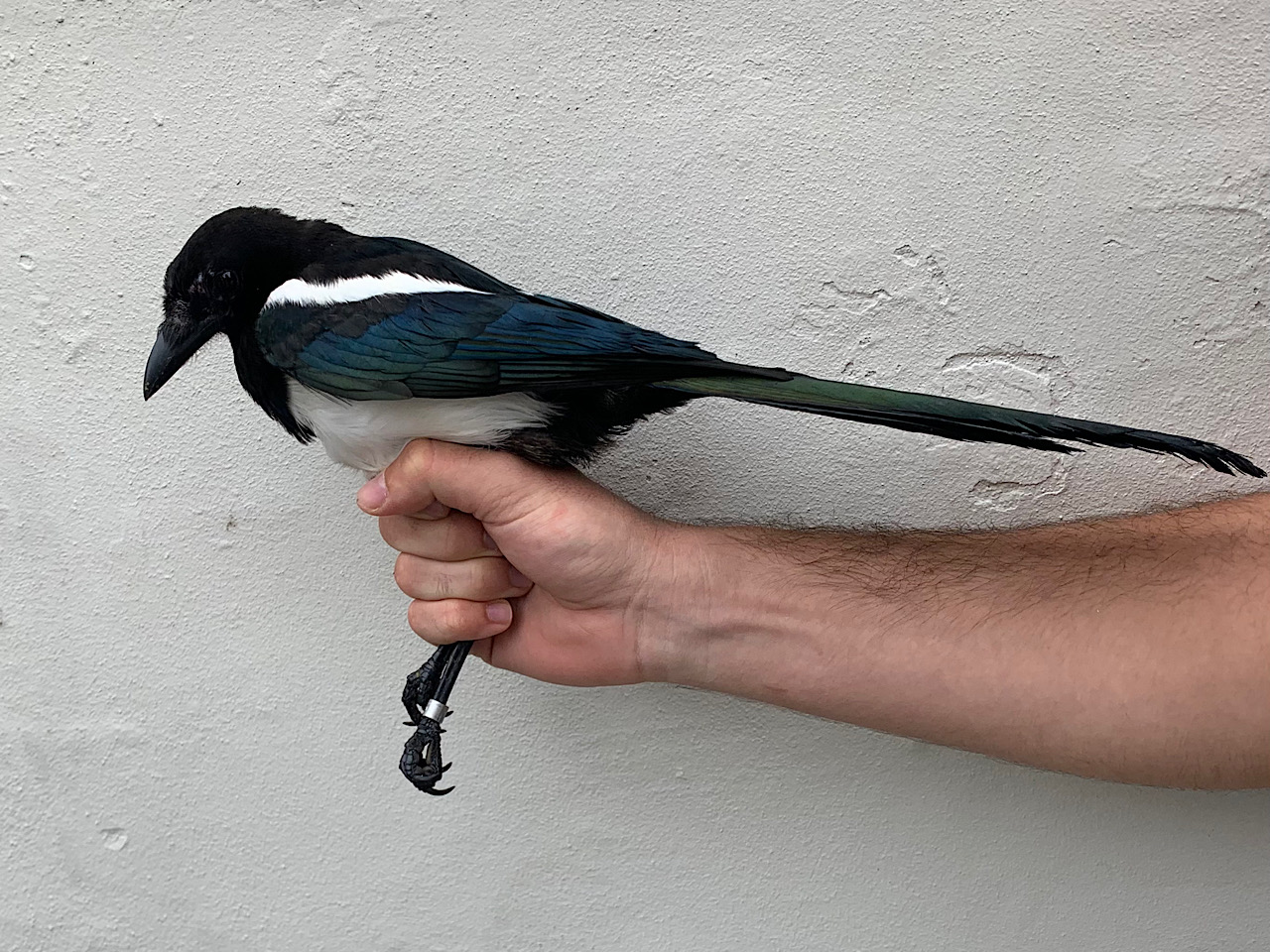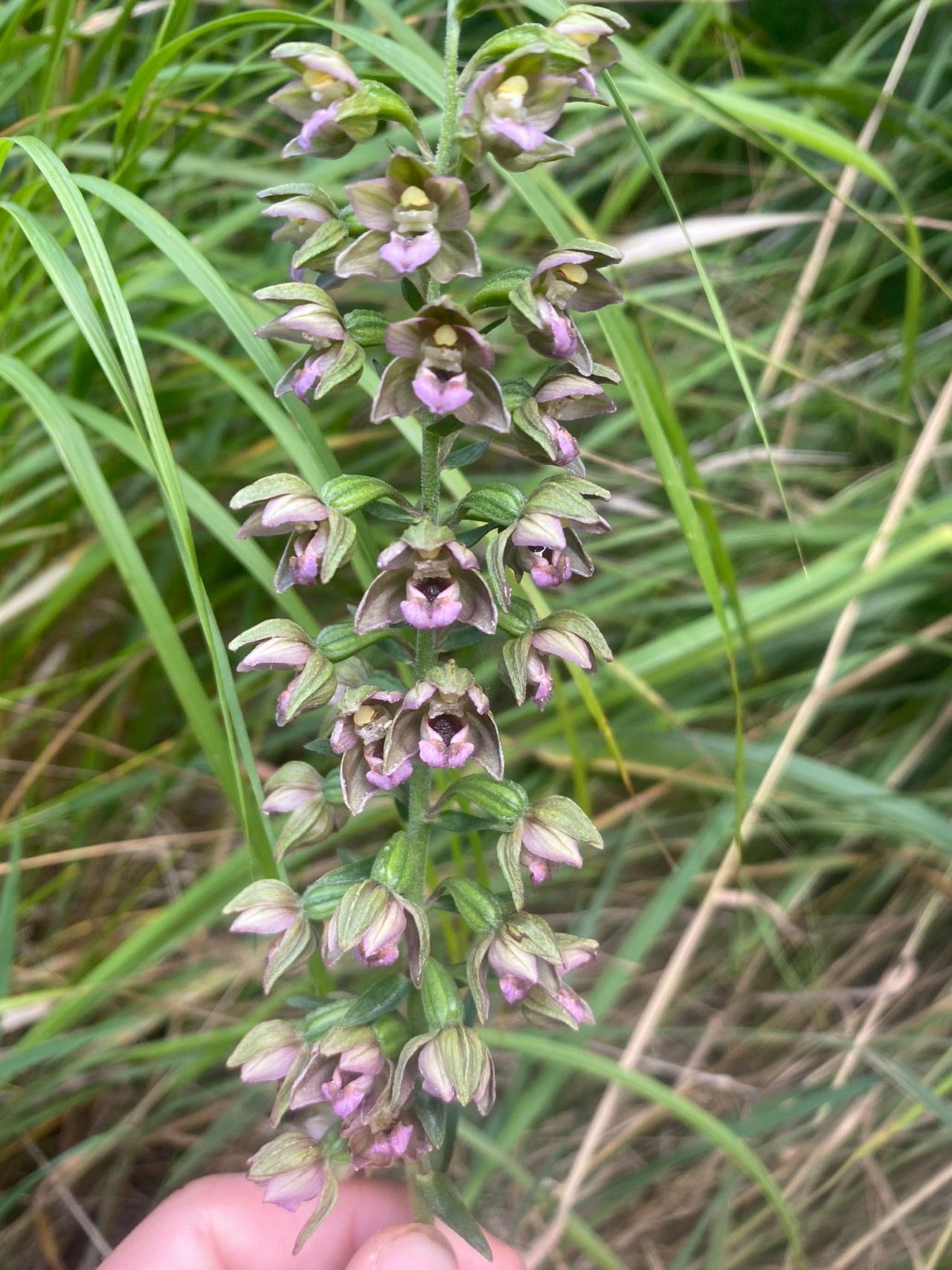Her på Skagen Fuglestations blog bringes korte nyheder i dagbogsformat om hændelser på fuglestationen.
Se indlæg fra måned: feb. (11)mar. (31)apr. (30)maj (31)juni (30)juli (31)aug. (31)sept. (30)okt. (31)nov. (30)dec. (6)
Landsvale Luck
Greetings, birdfolk
Today Robbie, myself, and Manuel (who arrived last night) split up for the day's field work. Robbie and I left for Kabeltromeln to ring at 4:15 am, while Manuel made it to World's End 3 by sunrise at 5:25 for a seawatch. The ringing this morning was quite productive, a high proportion of migrants amongst the regular assortment of local breeders. Unquestionably, highlights were a fieldfare (sjagger), barn swallow (landsvale), and 2 first year common redstarts (rødstjert). While barn swallow is among the most commonly-seen species in the area (and across the world, for that matter), they don't often swoop low enough to be caught in the mist nets, making today's capture special.
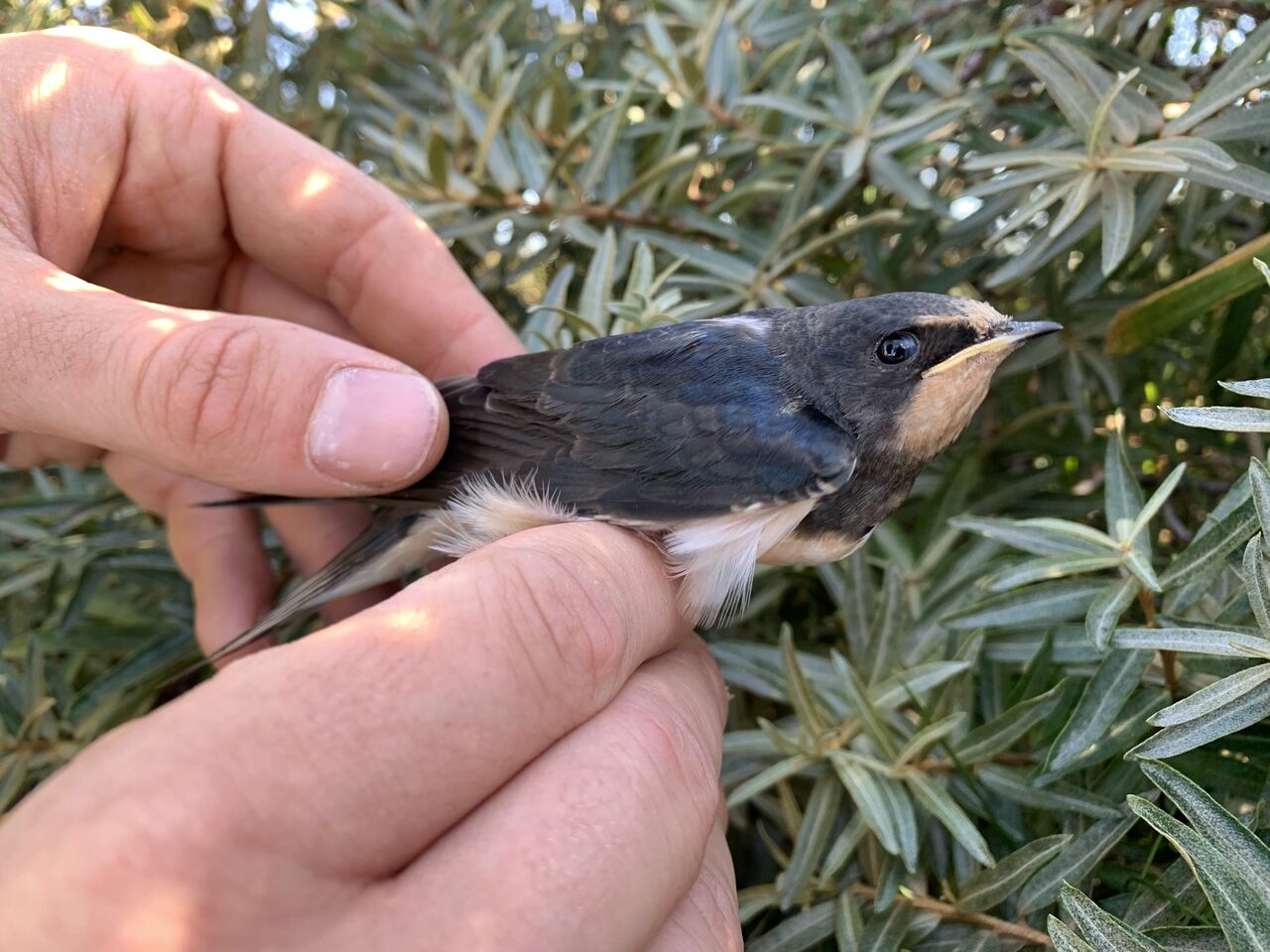
Barn Swallow (Landsvale)
Fieldfare is a species that primarily breeds further north in Norway, Sweden, Finland, etc. Over the past 2 centuries their range has undergone many expansions throughout Europe however, and they were first recorded breeding in Denmark in 1960. Today's first year bird was most likely hatched elsewhere, making its way to wintering grounds here in Denmark or further south in Europe.
Fieldfare (Sjagger)
Common Redstart is a species that does breed nearby, but given we haven't caught any juveniles at KAB this season, and that autumn migration has begun, it's very likely our 2 birds today were migrants. The nominate phoenicurus subspecies of common redstart which breeds here in Europe, NW Africa, and Siberia, is a long-distance migrant, spending the non-breeding season in the northern hemispheric Afrotropics. We wish these two the best of luck on their journey south.
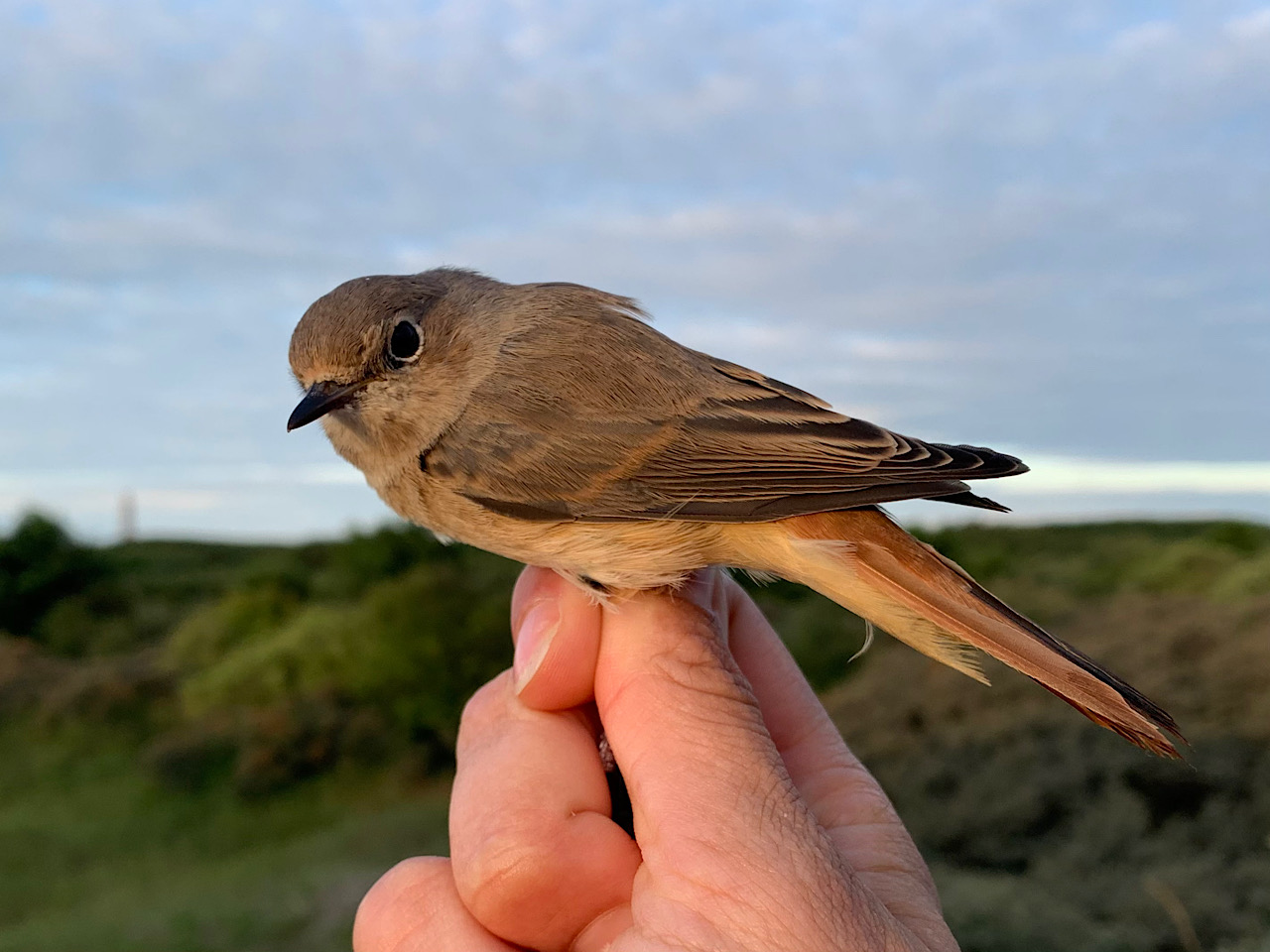
First year female common redstart.
Additionally, the male redstart showed a great example of a postjuvenile or formative molt limit, which is something that we will look for a lot further into autumn and before the next breeding season in order to age young birds a few months after they've hatched. For many birds, there's significant selective pressure for juveniles to grow their first set of feathers at once and rapidly, in order to leave the nest as soon as possible and avoid predation in the nest. Similarly, with a shorter need for parental care, there's a greater chance adults can produce a second brood. The tradeoff for a rapid, complete, and simultaneous prejuvenile molt is poor feather quality; juvenile feathers are often more susceptible to wear than adult feathers. So, many species have a partial molt as juveniles, called a postjuvenile or preformative molt to replace some of the poor quality juvenile feathers with more resilient adult-like feathers. In the photo below, you can see the young male redstart has done just this, with the replaced inner greater covert (and many body feathers) being newer, fresher, and grey in coloration, as opposed to the juvenile brown.
Meanwhile, Manuel over at World's End 3 had a decent day at the seawatch, with highlights being 2 dark morph Arctic skuas (almindelig kjove) chasing down terns together over the beach at Grenen, a great skua (storkjove) offshore, as well as some northern fulmars (mallemuk) migrating in the distance.
Tonight, we will attempt to catch some European storm-petrels (lille stormsvale) on the beach near the lighthouse. Wish us luck! We will post tomorrow if we are successful.
Peace,
Max
Ringing totals at Kabeltromeln:
Gransanger (Common Chiffchaff): 3
Lille Dompap (Eurasian Bullfinch): 1
Tornsanger (Common Whitethroat): 5
Munk (Eurasian Blackcap): 2
Landsvale (Barn Swallow): 1
Jernspurv (Dunnock): 1
Lille Gråsisken (Lesser Redpoll): 1
Musvit (Great Tit): 1
Sjagger (Fieldfare): 1
Gærdesanger (Lesser Whitethroat): 7
Kærsanger (Marsh Warbler): 2
Rørsanger (Eurasian Reed Warbler): 1
Rødstjert (Common Redstart): 2
Løvsanger (Willow Warbler): 14
Total: 42
Today's observations in DOFBasen from observers in the area
People: Max Laubstein, Robbie Lawler, Manuel Tacke, Lisa Vergin, Simon Christiansen, Dorothea Engert, Lina Kotschi, Joel Münch
An aerial displaying Arctic skua
It was yet another day without ringing today, though the conditions would have not been favorable. Instead, all the volunteers decided to have a joint effort with the observations. We were treated with some great views of an immature Artic skua (Almindelig Kjove), which is presumably the same bird that has been hunting close to shore for a few days now. This dark morph individual is really giving the local terns (ternes) some issues and it is always a pleasure to watch. Beyond the Skua we didn’t have many notable species, though a molting Black guillemot (Tejst) was an interesting sight. The roosting terns had been joined by greater numbers of Sandwich terns (Splitterne), which was some added variation. The sea was relatively empty in terms of migration with a few Fulmars (Mallemuk) being the highlight.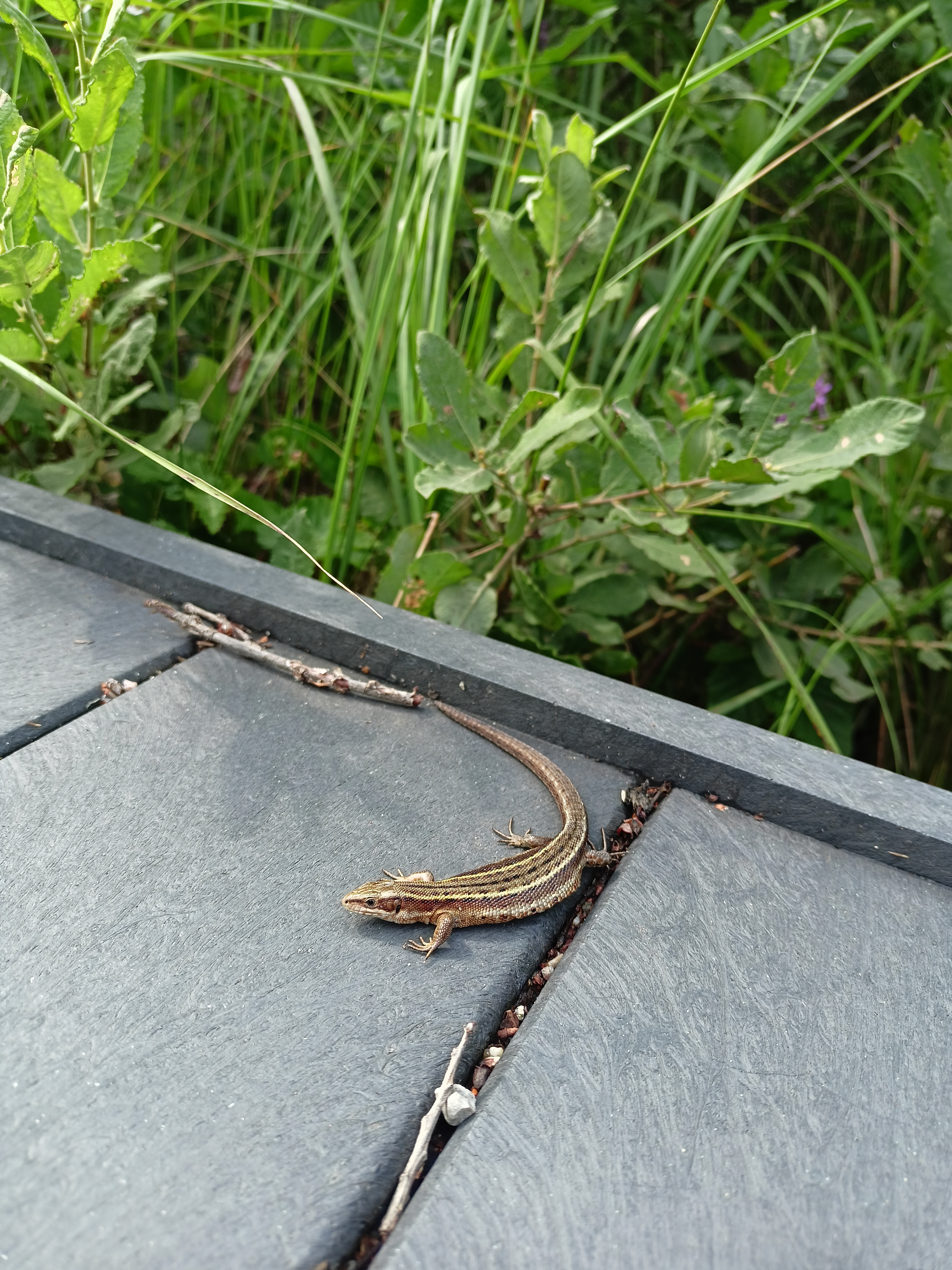
A common Lizard in the sun
Alice left us today and it is sad to see her go, though as with many volunteers here at Skagen she will most likely return. Speaking of returning volunteers - we are rejoined by Manuel today - thus the station maintains three volunteers from three countries.
Beyond the observations not much happened at the station today. Max made good progress with processing a nocturnal migration recording, and the results will appear on Trektellen soon enough: watch this space.
Today’s observations in Dofbasen from observers in the area
People: Alice Scalzo, Robbie Lawler, Max Laubstein, and Manuel.
Sunrise over the Gannets
This morning Robbie, Max, and I walked all the way to the tip for morning observations. The sun rose slowly as we looked upon the sea. We got nice sightings of a dark morph Arctic skua (Almindelig Kjove), a few waders passed by, and there was many Gannets (Sule) fishing in front of us.
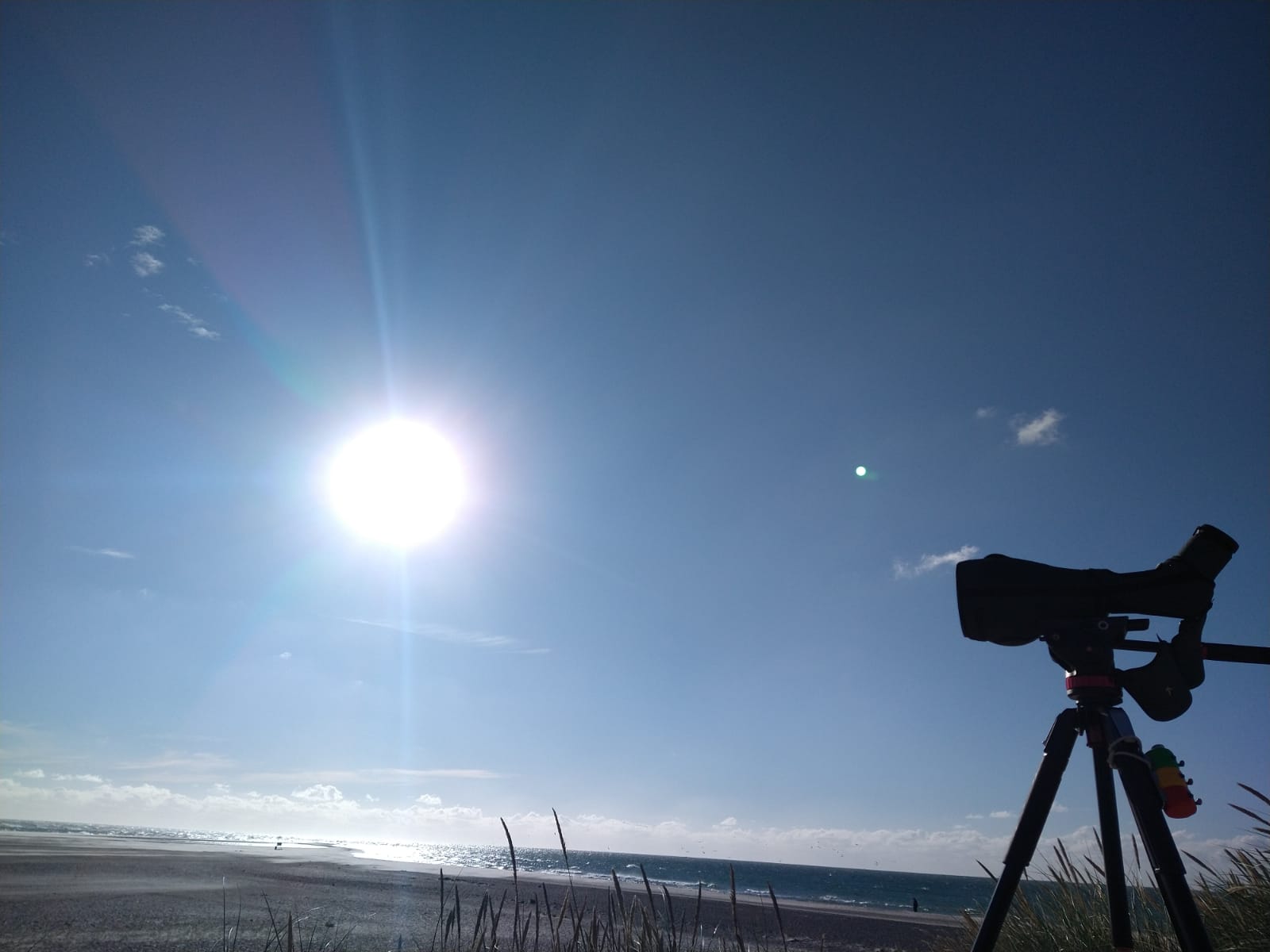 Nathan left the station this morning, we really enjoyed his presence here and wish him a good trip to the northern countries !
Nathan left the station this morning, we really enjoyed his presence here and wish him a good trip to the northern countries !People: Alice Scalzo, Max Laubstein, Robbie Lawler, and our guests Margit and Jesper.
Farewell Skagen !
Hello everyone,
Today was my last day in Skagen. It started with a morning of observations at the tip of the beach. We had a great view of Arctic Skua chasing gulls and terns above the water. We also spotted a Caspian Tern roosting in the middle of the flock.
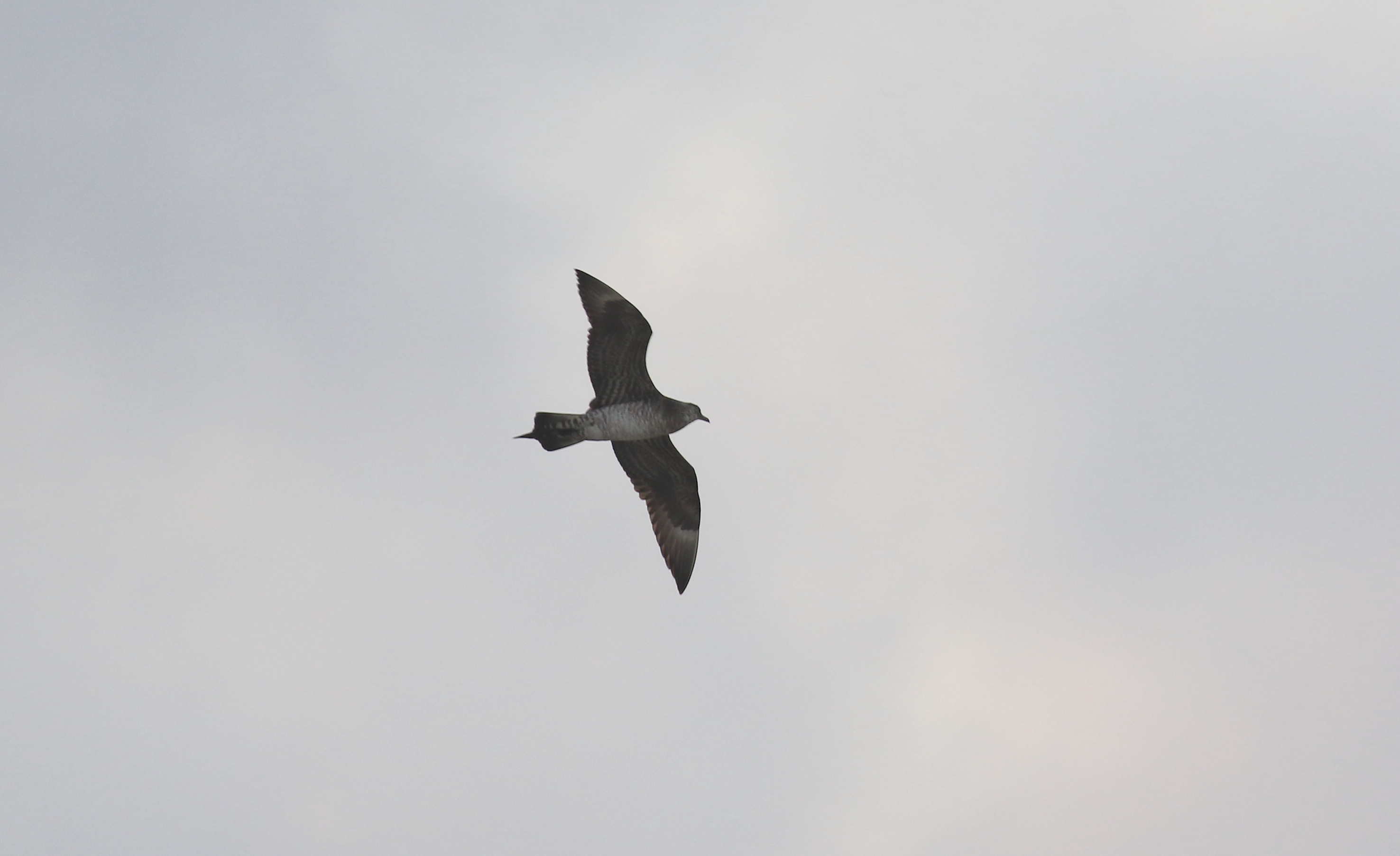
Arctic Skua flying above the beach
It was also Benjamin last day with us; We all hope he comes back as a volunteer for the Fuglestation in a couple of years.
Unfortunately, it was also my last day here.. I learned a lot when it comes to ringing, identifing and aging birds or seawatching. I want to thank every volunteers I have worked with here, who are amazing people but also the amazing birder community of Skagen that supported us through this month.
I really hope I'll be back soon to see even more of that amazing region.
Take care Skagen !
Nathan Delmas
Today’s observations in Dofbasen from observers in the area
People: Alice Scalzo, Robbie Lawler, Nathan Delmas, Max Laubstein, Benjamin Bech, Peter Kristensen, Knud Pederson, and our guests Margit and Jesper.
A wader and a wave goodbye to ringing
This is my first blog since Last November and it’s great to be back here in somewhat sunny Skagen. The last time I stepped foot in Skagen it was snowing/sleeting, and the streets were relatively empty. I was greeted by bustling streets and the calls of summer species when I arrived at the station a few days ago. Some things stay the same and some change and unfortunately just as last time there I was here there is yet another immediate threat to seabird populations in Northern Europe. In Autumn 2021 there was an Auk wreck in Britain and other areas of Northern Europe, which we saw arrive on the shore on Skagen through an unusually high number of dead Razorbills (Alks) and Guillemots (Lomvies); this issue is largely thought to be caused by a decline of certain prey species and possibly linked with climate change. The threat today is bird flu, which is less obviously connected to the degradation of ecosystems but has still nonetheless been exacerbated by human activity. I will write more about this in time here but hopefully, we don’t see the beaches fill with a high number of infected birds.
Today Oluf oversaw the ringing and whilst we weren’t inundated with high numbers, we did see an increase on the past few days and were treated to a Green Sandpiper (Svaleklire).
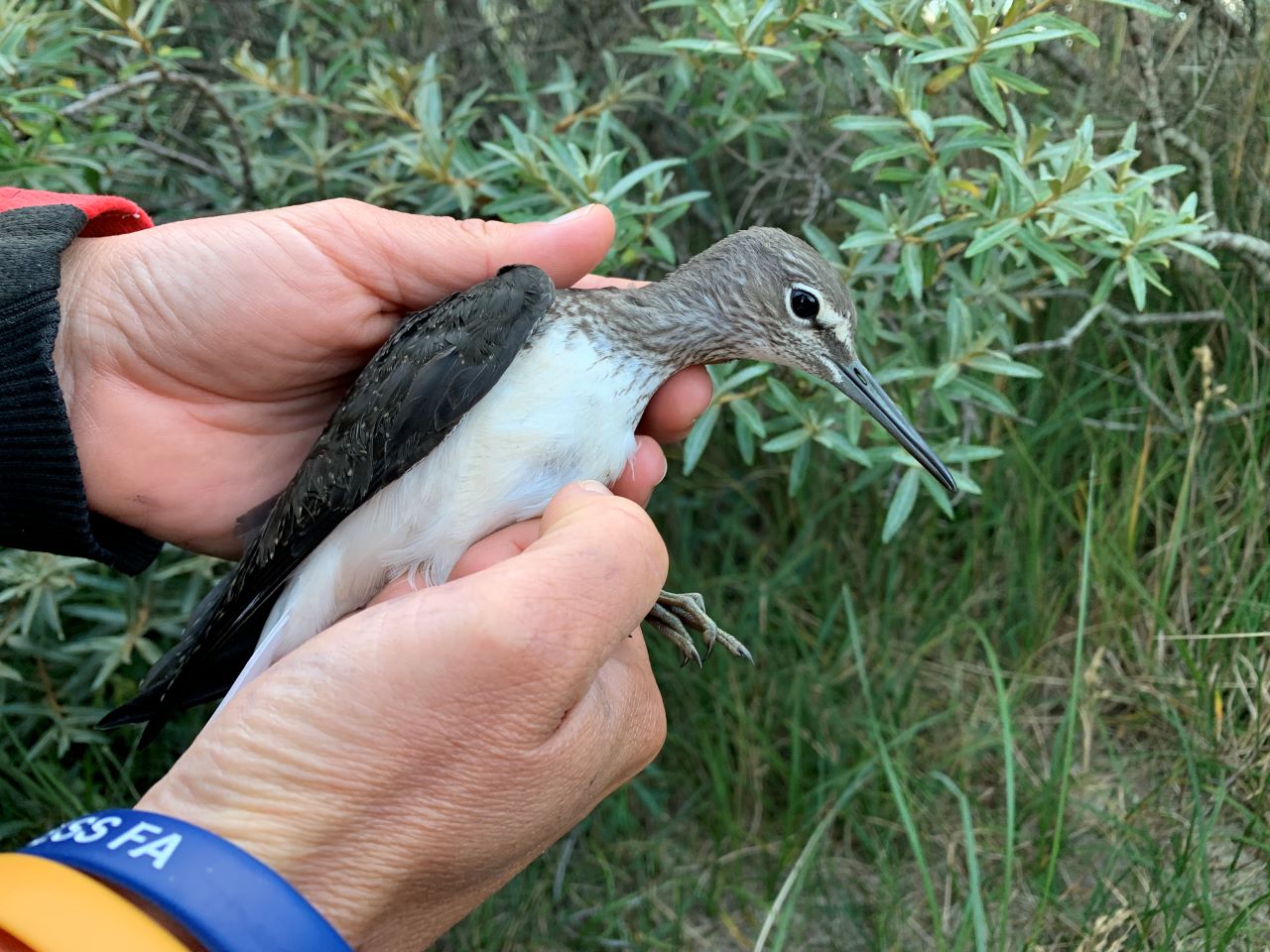
Today was most probably Nathan’s and Alice’s last ringing session due to poor weather conditions and Simon being away for a couple of days, The ringing today encompassed therefore some farewells; our loss is someone else’s gain. Benjamin joined us again today and was excited to see the Green Sandpiper (Svaleklire) up close.
Max sat at World’s End staring out to see and managed to spot a Black-throated diver and a Great White Egret. Several egret species have greatly expanded their range and numbers in many parts of Europe in recent decades and it is probable that such birds will become a much less notable occurrence here in Skagen in comings years.
Apologies for the late upload, I had some technical difficulties.
Robbie Lawler
Birds ringed at Kabeltromeln:
Gransanger 3
Rørspurv 1
Munk 2
Tornsanger 7
Lille Gråsisken 2
Rørsanger 5
Svaleklire 1
Gærdesanger 4
Total: 25
Today’s observations in Dofbasen from observers in the area
People: Alice Scalzo, Robbie Lawler, Nathan Delmas, Max Laubstein, Benjamin Bech, Peter Kristensen, Oluf Lou, and our guests Margit and Jesper.
Skua Score, a Mawing Magpie, and Motus Maintenance
Hi everyone!
The events of today's blog began as the clock struck midnight, while Robbie and I scanned the beaches of Grenen in the dark in an attempt to find (and capture) roosting shorebirds. While our attempts were in vain, we did manage to see several of the common ringed-plover chicks (stor praestekrave) which we ringed several weeks ago roaming the beach in the dark.
A short few hours after our return to the lighthouse, the sun began its ascent towards the horizon, and Alice and Robbie left to open the nets for a morning of ringing, and Nathan left for World's End 3 to conduct a seawatch, where he was joined by Benjamin. Undoubtedly, the highlight of the morning's field work was a long-tailed skua (lille kjove) spotted by Benjamin and Nathan! This makes the second sighting of this uncommon species here at Skagen in the past few weeks. Long-tailed skuas breed in the high Arctic and spend the non-breeding portion of the year in the open oceans of the Southern hemisphere. They typically don't pass through Denmark as they make the autumn journey South, so this is quite a noteable observation. Large numbers of long-tailed skuas were observed in Skagen one autumn in the late 1980's, putatively attributed to poor productivity on the breeding grounds. As for our two sightings so far this year, whether they can be explained by some systematic phenomenon further North, or simply randomness, is yet to be determined; we'll keep an eye out for more!
After the morning's fieldwork, we received a call from Lisa that she had captured a magpie (huskkade), which she brought to the fuglestation so it could be ringed. It was a treat to inspect the incredible irridescence of the magpie up close, and it put that classically snarky magpie persona on display by constantly biting its handler.
Peter Kristensen then joined Simon, Nathan, and I on a visit to get our local Motus tower back in working order. Motus is an international network of radio telemetry towers that can detect birds carrying transmitters as they migrate by. Today, we installed an extra transmitter on the tower (and a solar panel to power it) so that data collected at the tower can be wirelessly sent to us at the fuglestation for analysis. Projects like Motus generate incredibly valuable data for understanding where, when, and how birds migrate, which can correspondingly be used to predict the impacts of anthropogenic environmental changes on migration, and advance theories in migration ecology, among other things.
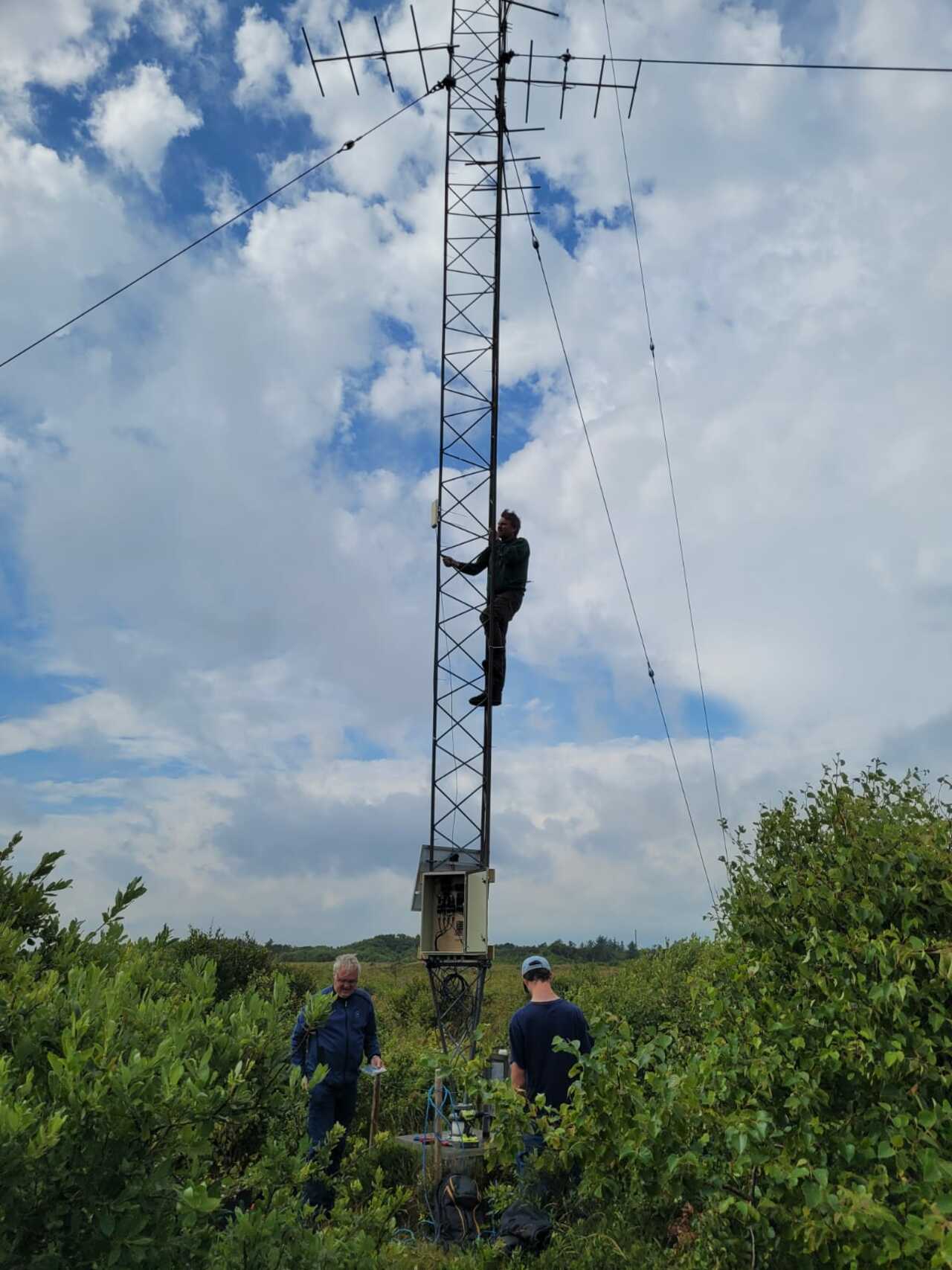
The Motus tower (Photo: Nathan)
Overall, it was quite a productive day!
Cheers,
Max
Birds ringed at Kabeltromeln
Garden warbler (Havesanger): 2
Common whitethroat (Tornsanger): 2
Eurasian blackcap (Munk): 1
Total: 5
Birds ringed at Fyrhaven
Eurasian magpie (Huskkade): 1
Today's observations in DOFBasen from observers in the area
A few birds and a new/old volunteer
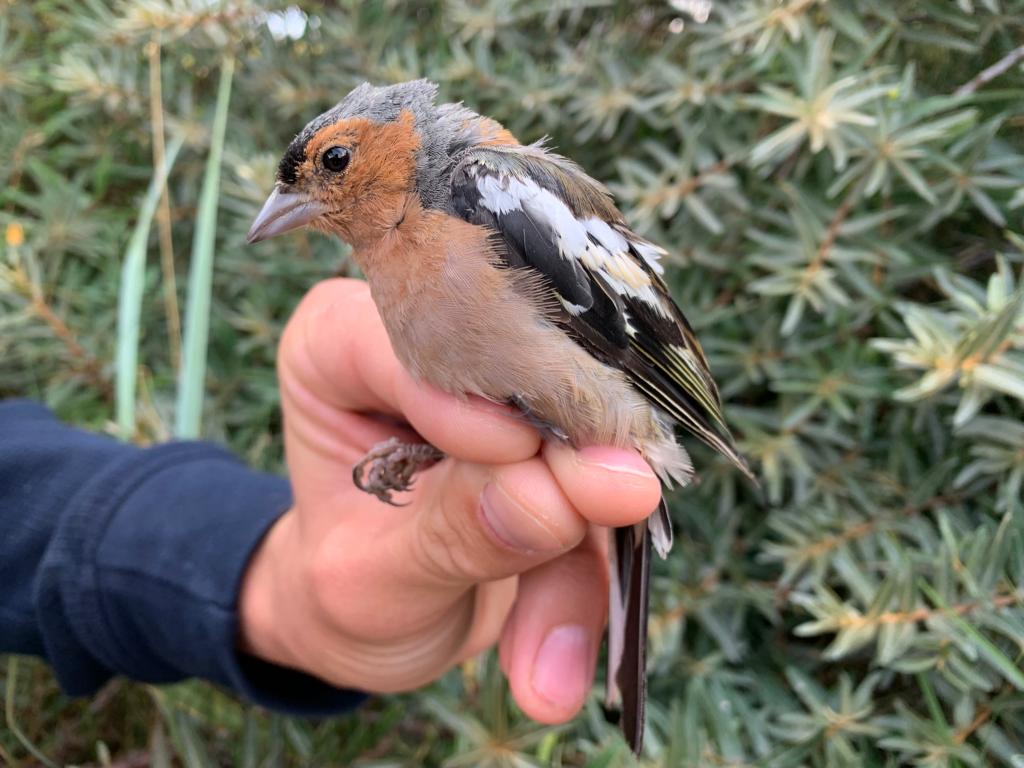 They had quite a decent ringing day but had to close early. They got a Chaffinch (Bogfinke), and two Sedge warblers (Sivsanger). Many waders passed by, and so they heard among others a Spotted redshank (Sortklire).
They had quite a decent ringing day but had to close early. They got a Chaffinch (Bogfinke), and two Sedge warblers (Sivsanger). Many waders passed by, and so they heard among others a Spotted redshank (Sortklire).
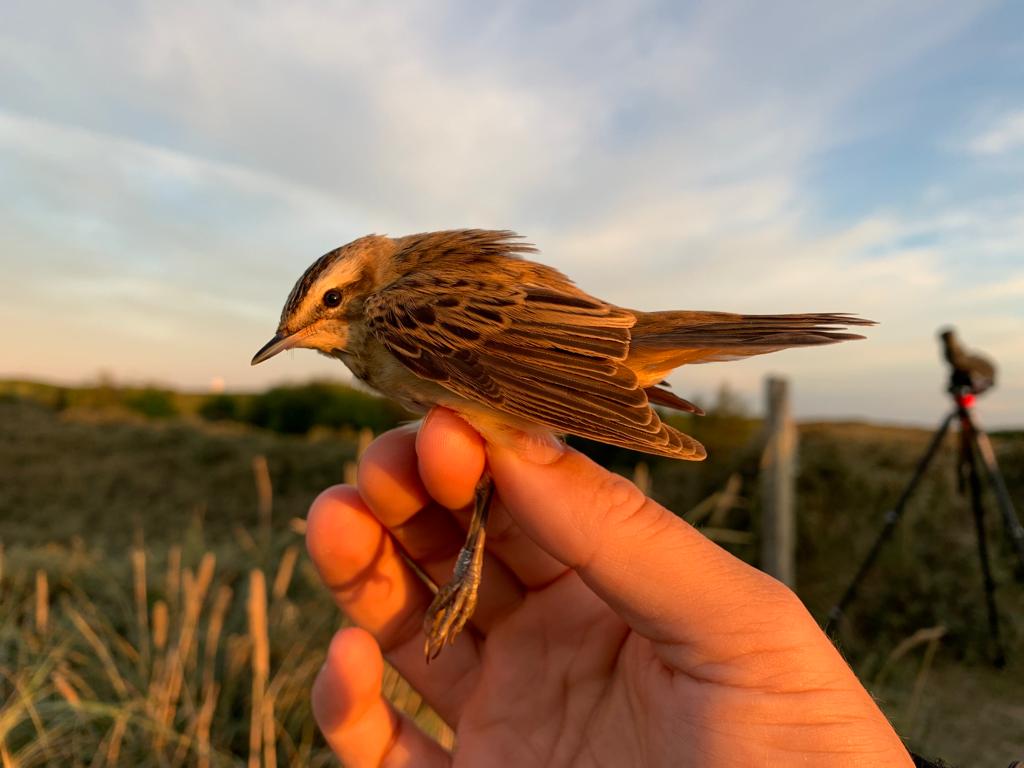 East of them, at the tip, was Benjamin, his uncle, and I sitting for morning observations. We got some juvenile Black guillemots (Tejst), an Arctic skua (Almindelig Kjove), a Kittiwake (Ride), the last two being new birds for Benjamin !, and a few waders in the first hours. Unfortunately there was little more. Today was not a migration day, but the sight of more than 200 Gannets (Sule) fishing in front of us made it worthwhile.
East of them, at the tip, was Benjamin, his uncle, and I sitting for morning observations. We got some juvenile Black guillemots (Tejst), an Arctic skua (Almindelig Kjove), a Kittiwake (Ride), the last two being new birds for Benjamin !, and a few waders in the first hours. Unfortunately there was little more. Today was not a migration day, but the sight of more than 200 Gannets (Sule) fishing in front of us made it worthwhile.A night full of surprises !
Hello everyone !
Very early this morning, and thanks to Alice's efforts, we caught 2 Red Knots on the beach near the lighthouse ! It was very exciting for everyone to be able to see from so close a bird we are used to see through the scope.
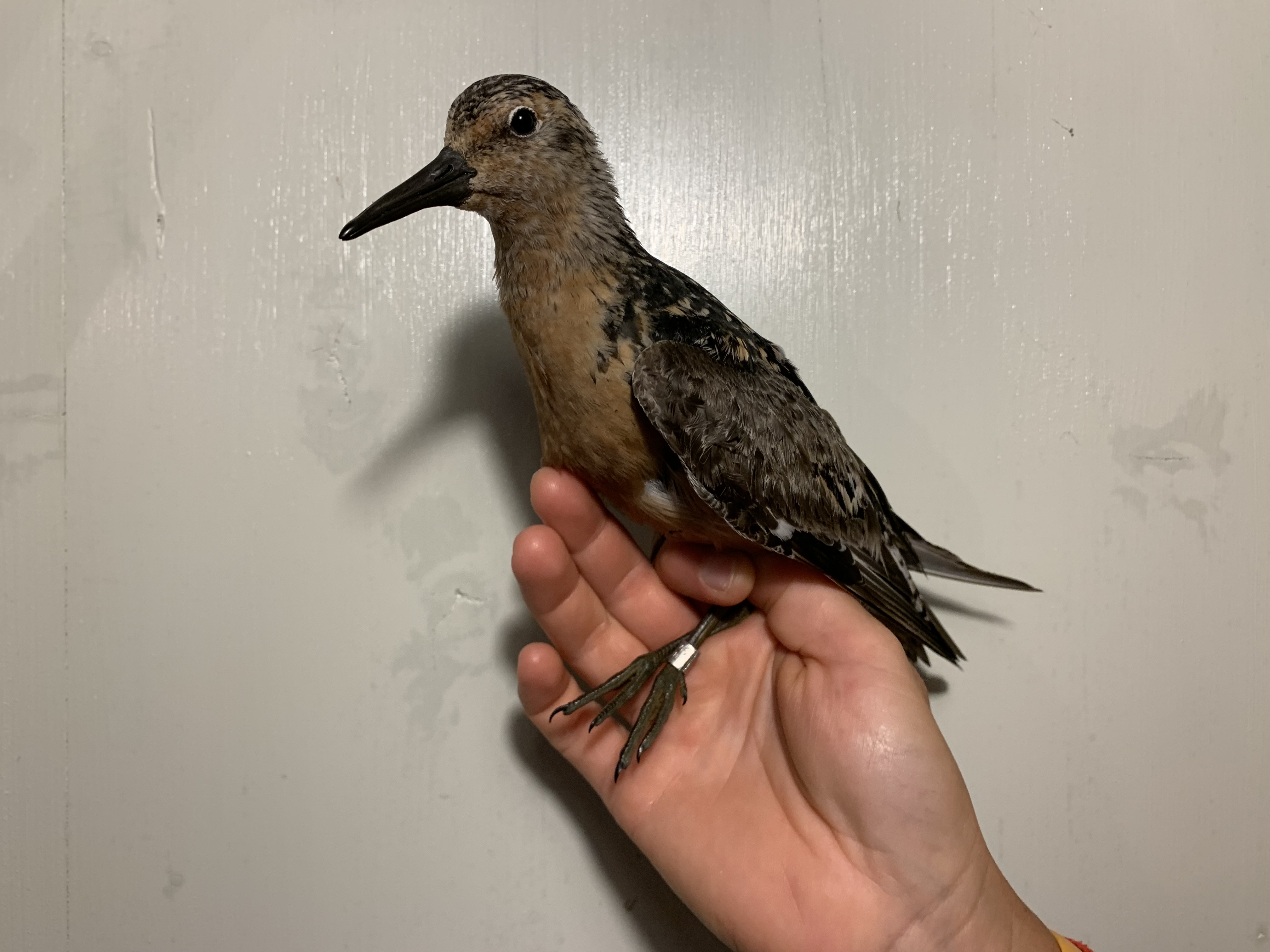
A Red Knot ringed by Skagen Fuglestation (Max)
Soon after, Martina and I went to open the nets while Max went observing on the beach. Simon joined later accompanied by Benjamin who is going to help us during this week. Benjamin is 13 years old danish boy who has been introduced to birding by his uncle and wanted to learn more about ringing with us. We managed to catch and ring a beautiful spotted flycatcher ! A bit later, Alice joined to help us despite the fact that she worked all night.
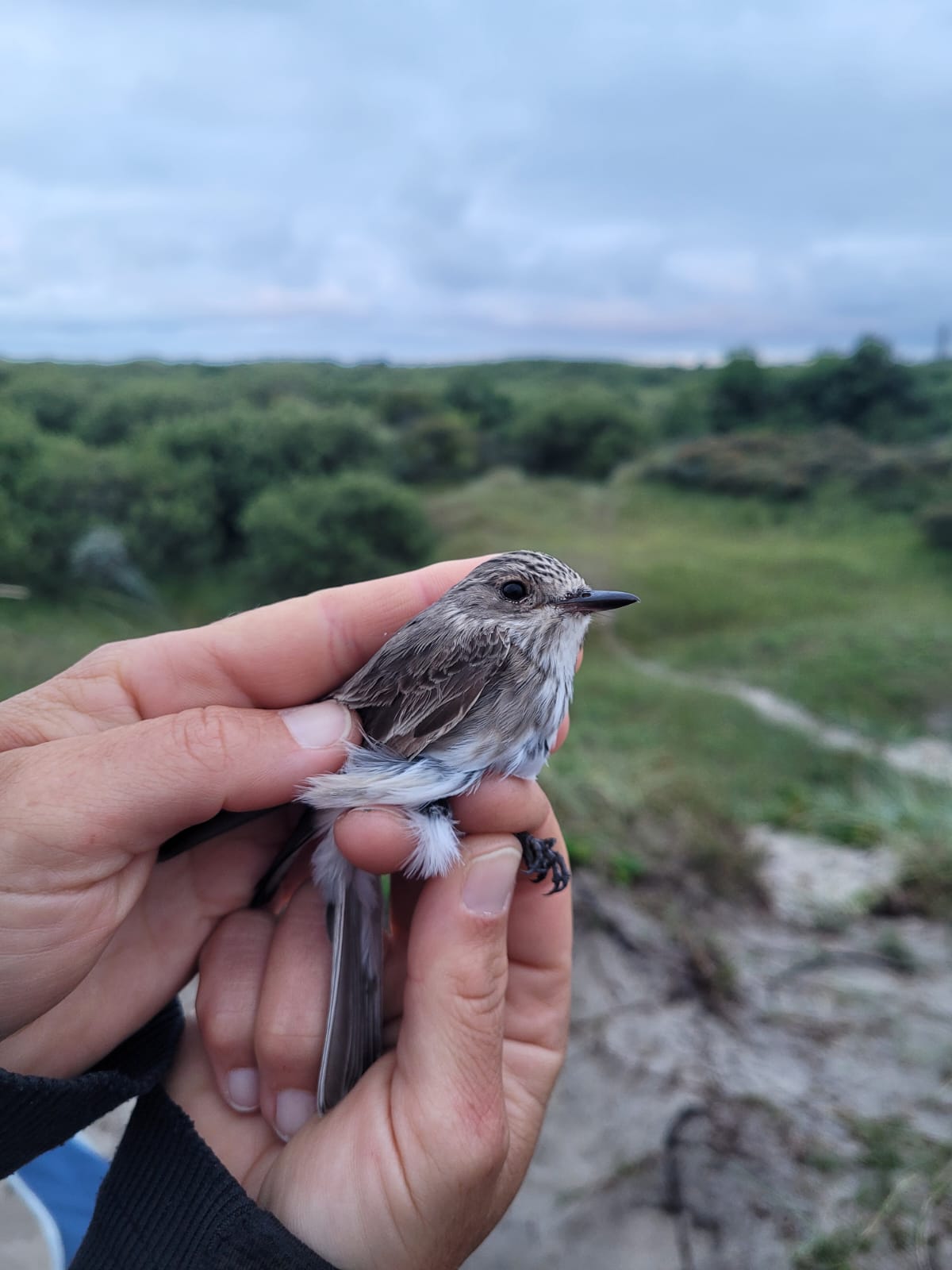
A spotted flycatcher (Nathan)
After that, we went back to the station and it was time for Martina to pack her bag and go back to Germany to prepare her classes. We deeply thank her for all the work she has done for the Fuglestation and also for all the valuable knowledge she transmitted to other volunteers.
That is it for today, we wish you a great evening and we will see each other tomorrow for more exciting news about birds !
Ringing (Kabeltromeln):
Munk (Blackcap) 2
Løvsanger (Willow Warbler) 1
Tornsanger (Common Whitethroat) 4
Grå Fluesnapper (Spotted Flycatcher) 1
Ringing (Stranden Det Grå Fyr):
Islandsk Ryle (Red knot) 2
Total: 10
Today’s observations in Dofbasen from observers in the area
People: Alice Scalzo, Nathan Delmas, Max Laubstein, Martina Hillbrand, Simon S. Christiansen, Benjamin Bech and our guests Finn and Marianne
Goodbye and thanks for the birds
Max and Simon were out again last night in the hope of catching more storm petrels (stormsvale), but the weather was not really good any more since it was starting to get windy and I guess we have been lucky once so we shouldn’t complain about not getting more.
In order to make up for the bad luck they had had at night, Alice and I went to the ringing at Kabeltromlen early in the morning and we did get quite lucky! We had a fair number of birds on every net check, not too many and not too few. It was actually a perfect day for ringing. We had mostly the same old species and still not a lot of migration or birds that we only catch on migration but again lots of juvenile Whitethroats (tornsanger og gærdesanger), showing that obviously it has been a year with good breeding success for these species.
To brighten up our day even more, a great spotted woodpecker (stor flagspætte) came for a visit around the area. We heard and saw him first and then suddenly we couldn’t hear him any more so I had an inkling that maybe it was in one of our nets and it was! It was a juvenile, probably born rather recently in one of the forested areas around Skagen that was wondering about to explore the area.
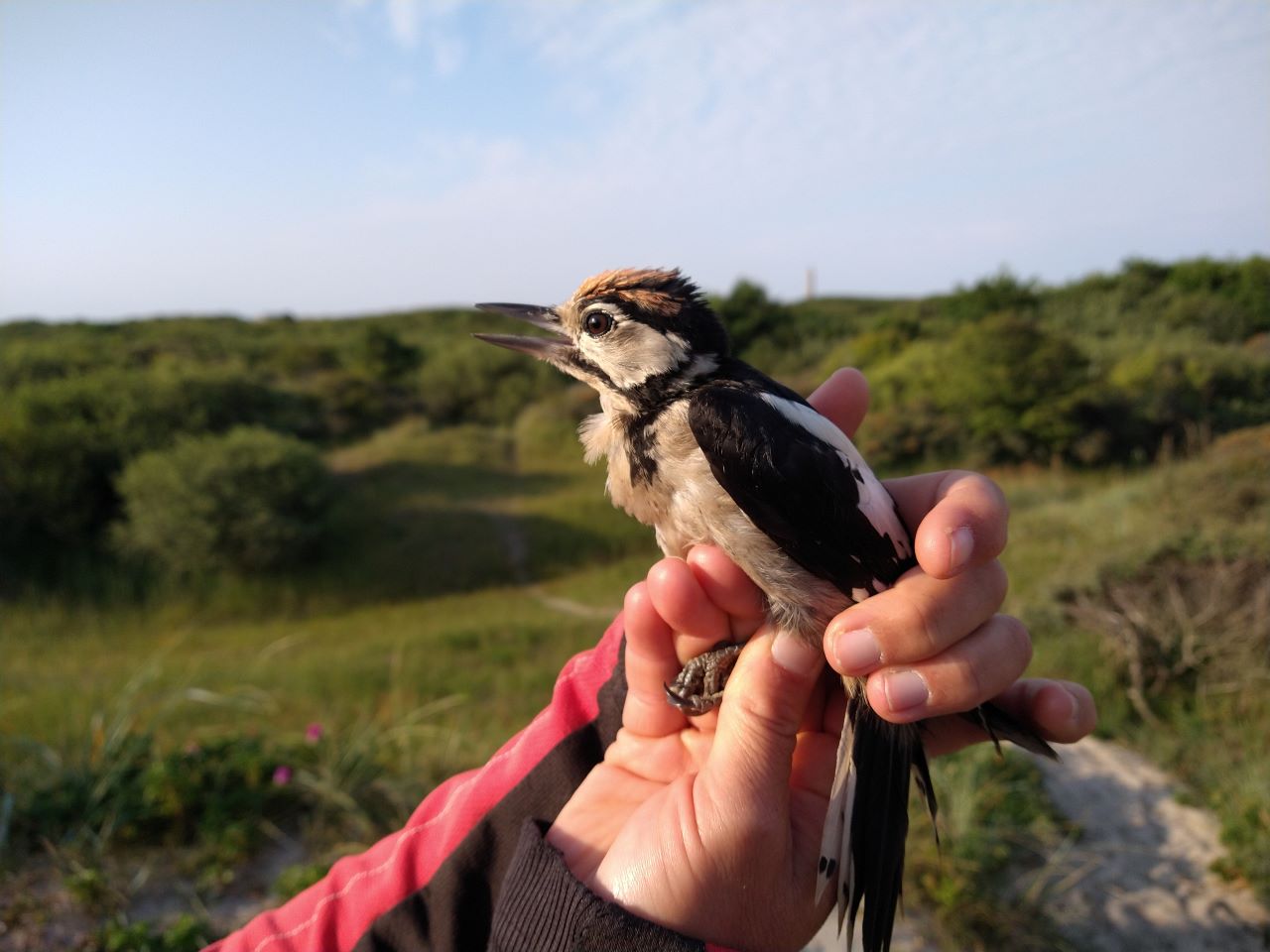
Another woodpecker species, the wryneck (vendehals) also visited us again at the ringing. It was caught in the nets in the last net check before closing and the ring it had revealed it was the same bird that we ringed the other day.
In the late morning Simon guided a walking tour around Grenen and he took the visitors to also see the ringing. They got to see the obligatory tornsangers after looking at some rare orchids on the way out.
While Alice and I were ringing, Nathan did the sea watch. There wasn’t a lot of migration happening, but he did see quite a few shorebirds roosting on the beach, including 18 dunlins (almindelig ryle). Other than that he saw 4 dead young seals on the beach, which was very sad. We don’t know what they died from but hope there won’t be more!
In the afternoon after the obligatory data entry, we welcomed our new guests for the coming week. It is their first stay here, so they don’t know yet what they are up for but we hope they will enjoy it anyways.
And a rather sad notice: I am leaving tomorrow to go back to Germany where the summer holidays end in 2 weeks and I have to work again. In order to not have to miss all of autumn migration, I made arrangements to take a group of students on a field trip to Skagen in September. Hope everything works out fine.
I have been here less than a month this time and, of course, time flies. It’s sad that I didn’t get the busy days of migration, but we did get two foreign recaptures and despite them getting a bit boring after ringing so many, I do love tornsangers and gærdesangers and I am happy that they have lots of babies. Obviously the single most thrilling event during my stay here was the catching and ringing of the storm petrel (stormsvale) yesterday in the early morning. They are such amazing creatures and lead such an interesting life. Also, their plumage is very thick and soft and they have a gland on their nose to get rid of salt from sea water. The gland makes them look a bit strange but they are extremely pretty birds.
So, all that is left to say for now is thanks for all the good birds and for the good times and hope to be out again soon! Take good care everyone and keep birding!
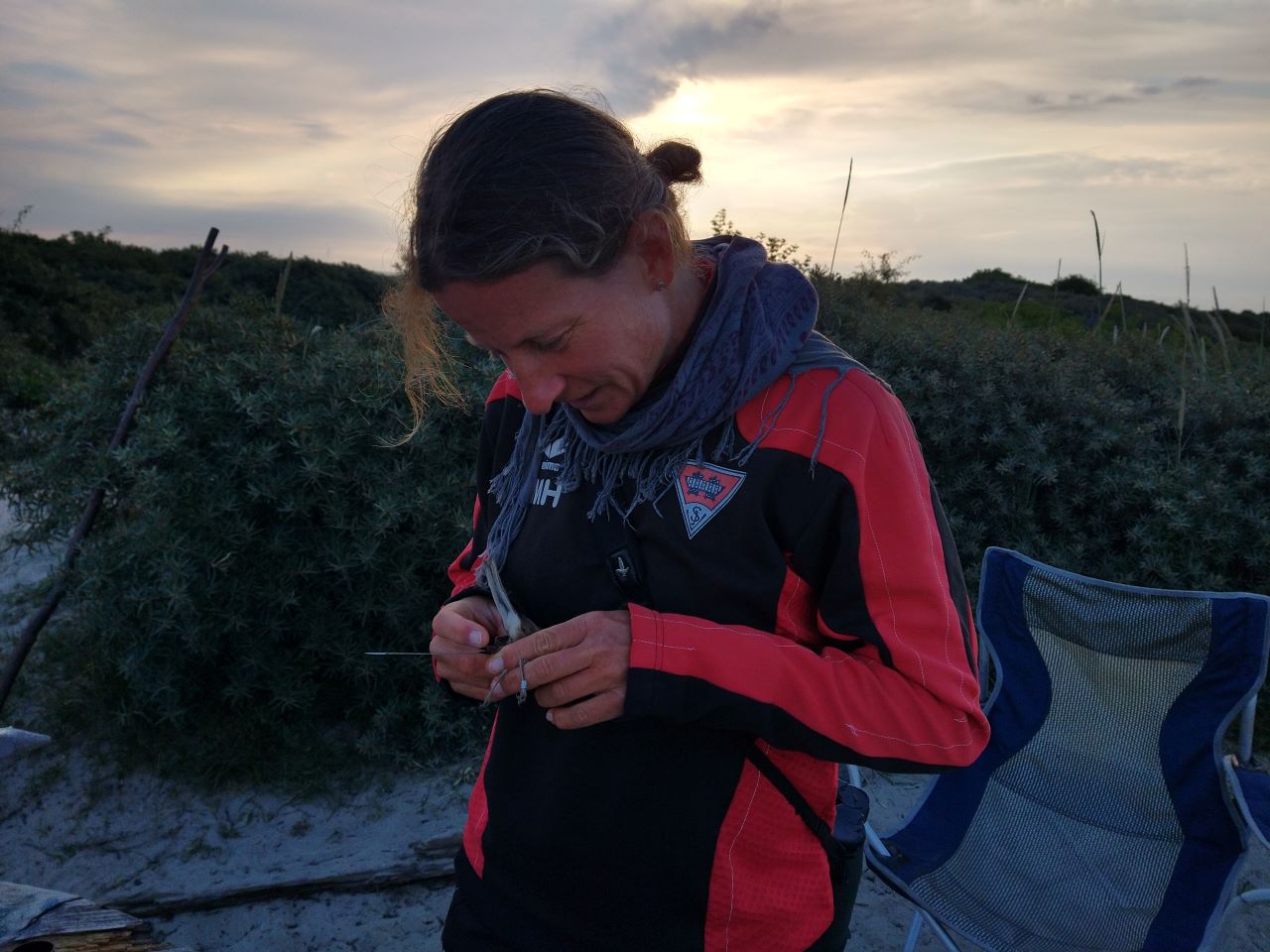
Ringing (Kabeltromeln):
Stor flagspætte (Great Spotted Woodpecker) 1
Solsort (Blackbird) 1
Musvit (Great Tit) 1
Tornsanger (Common Whitethroat) 16
Munk (Blackcap) 10)
Løvsanger (Willow Warbler) 1
Gærdesanger (Lesser Whitethroat) 3
Rørsanger (Reed Warbler) 3
Kærsanger (Marsh Warbler) 2
Gransanger (Chiffchaff) 1
total: 39
Today’s observations in Dofbasen from observers in the area
People: Alice Scalzo, Nathan Delmas, Max Laubstein, Martina Hillbrand, Simon S. Christiansen and our guests Finn and Marianne
Luck from the shore
Last night Martina was on duty to check the nets every now and then while we were sleeping soundly. I remember being suddenly awake at 01:55 in the night by the sound of her voice saying "if you want to see a Storm Petrel (Lille Stormsval) it's now". Luck was on our side ! It was only one bird, but it was the bird we were all hoping for. A few birders also came to see it. We were all so happy about our catch that it was hard to go back to sleep afterwards.
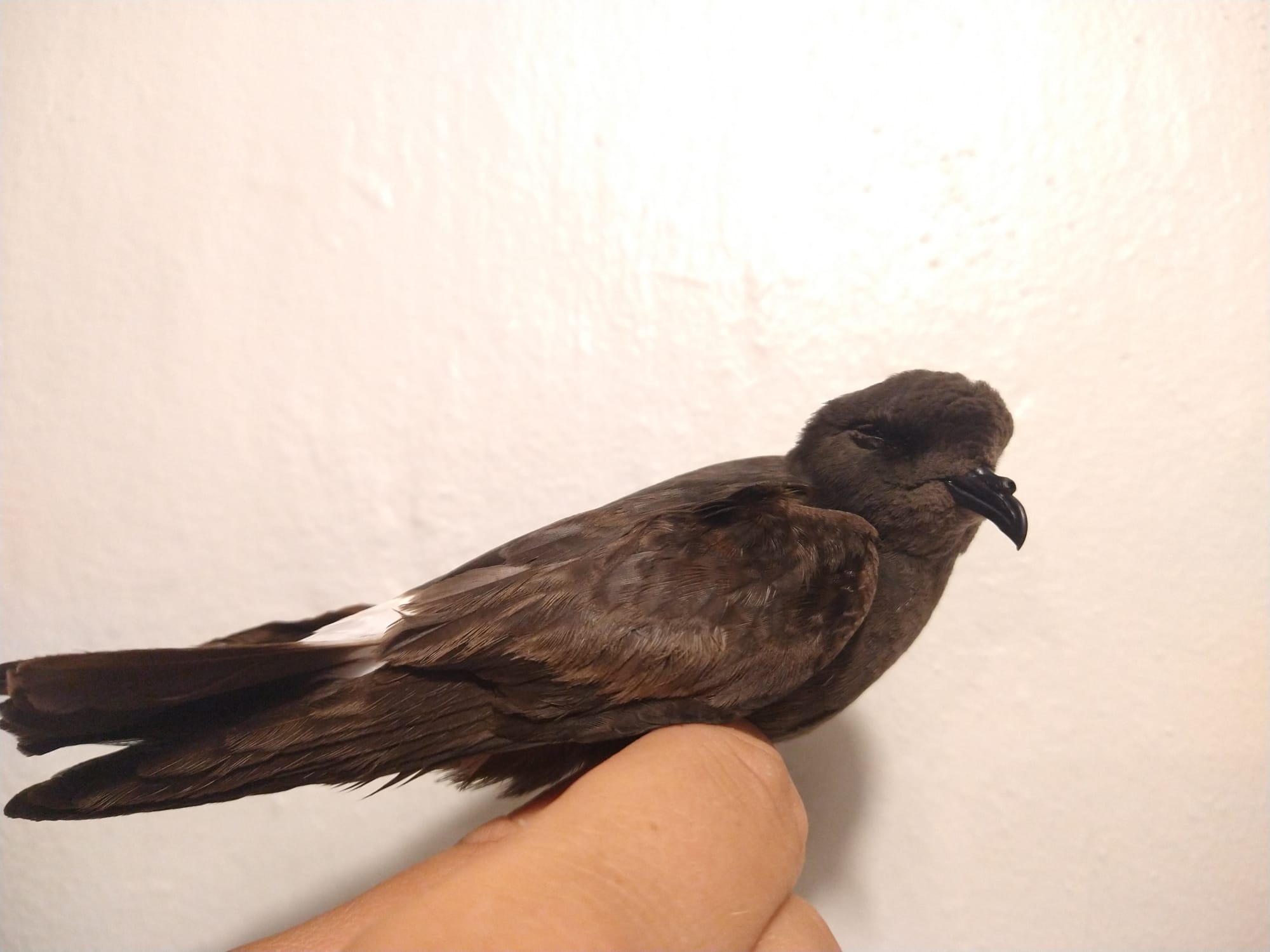 This morning was less eventful. I was on sea watch while Nathan and Max went ringing with Simon, Lisa, and two Swedish friends. The hours passed slowly as there was very few birds migrating, only the last hour brought some waders migrating and a resting Black tern (Sortterne) on the beach.
This morning was less eventful. I was on sea watch while Nathan and Max went ringing with Simon, Lisa, and two Swedish friends. The hours passed slowly as there was very few birds migrating, only the last hour brought some waders migrating and a resting Black tern (Sortterne) on the beach.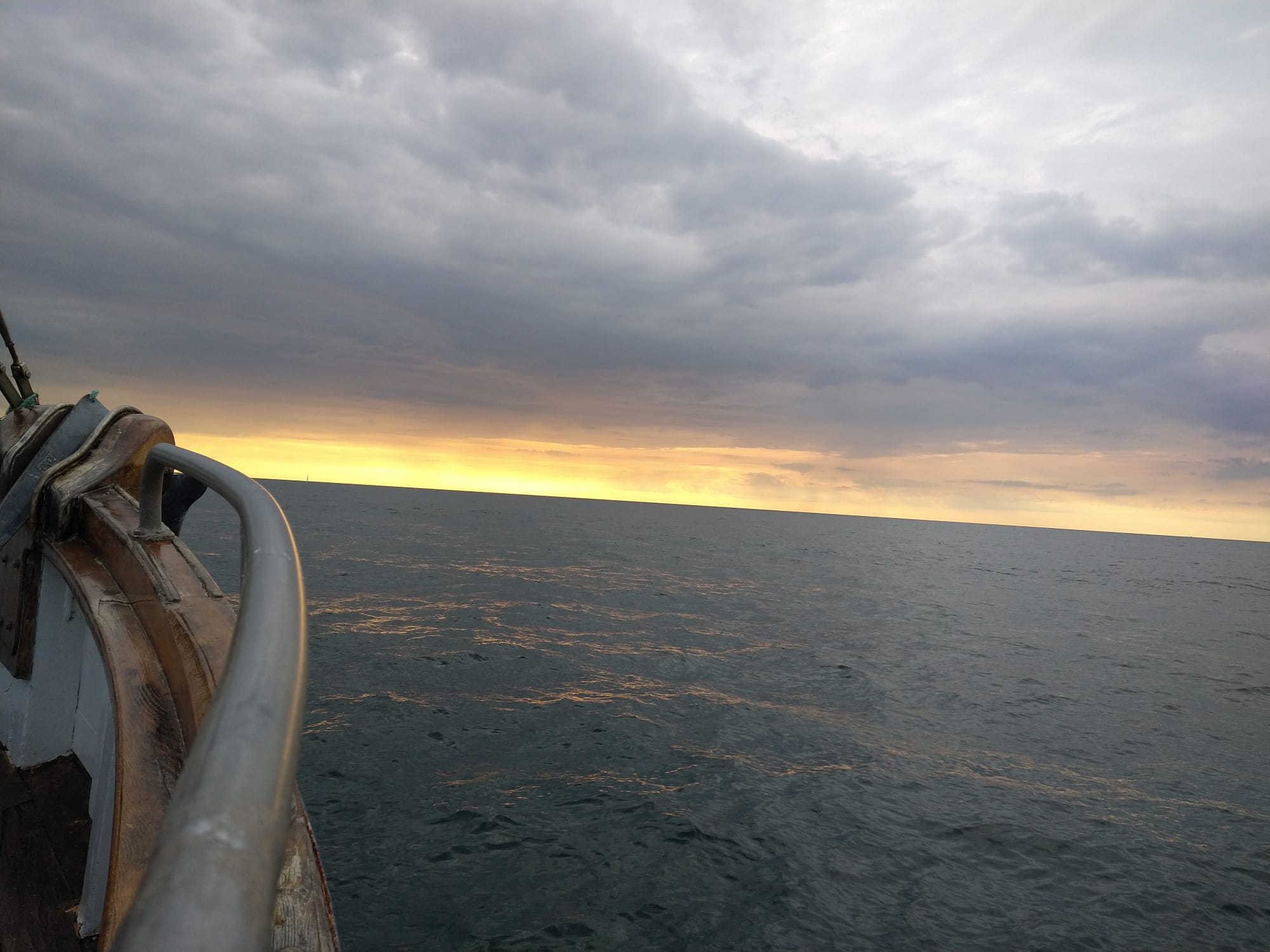 We also got news from a color ringed Greater Black-backed gull (Svartbag) who was ringed in Hirsholmene in 2010. We saw it a few days ago at the beach, which makes it 12 years old gull, and funny thing is that he was spotted a few years ago in a town where I lived in France !
We also got news from a color ringed Greater Black-backed gull (Svartbag) who was ringed in Hirsholmene in 2010. We saw it a few days ago at the beach, which makes it 12 years old gull, and funny thing is that he was spotted a few years ago in a town where I lived in France !People: Rita DeLucco, Alice Scalzo, Nathan Delmas, Max Laubstein, Martina Hillbrand, Simon S. Christiansen, Lisa Vergin, Per Österman, Johanna and our guests Margit and Jesper.
